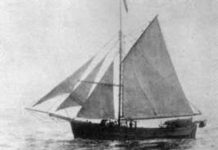The battle which Adam Dollard des Ormeaux and his comrades fought against Iroquois warriors at Long Sault in 1660 was an offshoot of the struggle to control the Canadian fur trade, specifically beaver pelts. The economies of the French colonies on the St. Lawrence River – Quebec, Trois Rivieres and Ville Marie (present day Montreal) – were dependent on this trade: furs obtained via trade with native peoples, primarily the Hurons and Algonquins, were subsequently exchanged for manufactured goods and other essential materials shipped from France. Since 1645, the Five Nations of the Iroquois Confederacy (Cayuga, Mohawk, Oneida, Onondaga and Seneca) had waged constant war against the Huron and Algonquin peoples, seeking to usurp their lucrative role in the fur trade and to divert that trade to their Dutch allies on the Hudson River.
The Hurons and Algonquins transported their beaver pelts to the French colonies in canoe flotillas that travelled down the Ottawa River to the St. Lawrence. The Iroquois successfully disrupted this activity by blockading the Ottawa with large groups of warriors: they would either rob the flotillas of their furs or force them to turn back. Unlike Quebec and Trois Rivieres, Ville Marie was entirely dependent on the Ottawa supply route for furs, so the Iroquois blockade created a mortal danger to the colony. By the summer of 1659, no pelts were reaching Ville Marie.
Dollard’s Intent
Adam Dollard, Sieur des Ormeaux, saw opportunity in this crisis. A young man with a military background, well-regarded by Ville Marie’s founder and governor Maisonneuve, Dollard had seen several residents of the colony grow wealthy from the fur trade and was eager to emulate them. He had determined that when the Iroquois brought furs they had either trapped themselves or plundered via their blockade down the Ottawa, bound for the Dutch trading posts, they travelled in small groups. Furthermore, when passing rapids on that river, they were forced to paddle in single file, close to shore. Dollard’s plan, as he described it to the coureur de bois Pierre Radisson and others, was to lie in wait by the rapids, then ambush and kill the passing Iroquois, steal their furs and deliver them to Ville Marie. As the sole source of furs for the desperate colony, he expected to become rich from this enterprise.
With Maisonneuve’s consent, Dollard recruited sixteen volunteers for the mission. They departed Ville Marie in canoes on 19 April 1660, paddling westward along the St. Lawrence.
Long Sault
On 1 May, the group reached Long Sault, close by the Chute a Blondeau rapids at the confluence of the Ottawa and St. Lawrence rivers (near present-day Carillon). Dollard chose a site on the north shore of the Ottawa, adjacent to a long-abandoned stockade. Later that day, four Algonquin and forty Huron warriors joined his force.
The following day, they ambushed two canoes carrying fifteen Onondaga warriors, killing thirteen. Two escaped, and fled back up the Ottawa to rejoin the main body of two hundred warriors who were blockading the river. Knowing neither the number nor the nature of their enemy, but determined to avenge their dead, the entire group launched their canoes and paddled furiously downstream.
Dollard Under Seige
Surprised by the sudden appearance of the Onondagas, Dollard and his men raced into the stockade. It provided them a strong defensive position from which they repulsed the initial assault, killing and wounding sixteen attackers without losing a man.
The Onondagas decided reinforcements were needed. Messengers were dispatched to a large Mohawk war party lurking in the Richelieu Valley east of Ville Marie, preparing for an assault to annihilate the colony. While awaiting their confederates, the Onondagas kept Dollard and his companions pinned down in the stockade with continual gunfire. Hunger, thirst and fatigue weakened the defenders.
After seven days, a fleet of canoes bearing five hundred Mohawks and fifty Oneidas appeared. For the next three days, the enlarged Iroquois force maintained a constant harassment of Dollard’s company while they planned their final assault. They also persuaded twenty-six Hurons to abandon the stockade.
The Final Assault
On the morning of the fourth day, the Iroquois attacked from all sides. Warriors carrying torches and crude wooden shields charged the stockade, attempting to cut their way through the stakes while their fellows rained gunfire on the defenders. Dollard had made an impromptu explosive device, a keg of gunpowder with a burning wick attached, which he attempted to hurl over the stockade amongst the Iroquois, Instead, the projectile fell back inside and exploded among his own men, killing some and blinding others. The stockade wall was breached and the Iroquois swarmed in, striking down the defenders in hand-to-hand combat. They then scalped the dead, including Dollard, tortured badly-wounded survivors to death, and made prisoners of five Frenchmen and several Hurons.
Aftemath
After the battle, the Onondagas did not resume their blockade of the Ottawa, and the Mohawks did not return to the Richelieu Valley. Instead, as was their custom after a victory, they departed for their respective countries south of Lake Ontario to display their trophies, celebrate and resupply themselves. This was salutary for Ville Marie in two ways: the planned Mohawk assault to destroy the colony was abandoned and, with the blockade gone, furs could again be brought down the Ottawa route. In August, a fleet of sixty canoes manned by three hundred Ottawa warriors reached Ville Marie: local merchants were able to procure 50,000 pounds of beaver pelts.
It would later be claimed that Dollard and his companions had known in advance of the large Iroquois force on the Ottawa and had set out to intercept it, deliberately sacrificing themselves to save Ville Marie. While this scenario was useful to the colony’s leaders, creating an example of heroism and personal sacrifice, it ignores Dollard’s stated objectives for his undertaking.
Source:
Lanctot, Gustave. Montreal Under Maisonneuve 1642-1665. Clarke, Irwin & Company Limited, Toronto, Vancouver, 1969.







